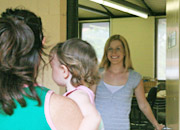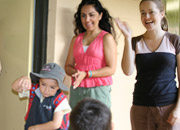Behaviour
Caring for babies
Bottle feeding
Changing a nappy
Cleaning and sterilising bottles
Daily cleaning tasks
Helping new children settle in
Preparing for a nappy change
Sleep patterns – babies
Sleep routines – babies
Toilet training
Caring for children
Allowing time for practice
Dressing/undressing
Mealtimes
Nappy change
Packing away/caring for the environment
Sleep/rest time
Toileting
Common self-help milestones
Tips for sleep and rest time
Self image
Communication
Body language
Limits and guidelines
Ways children communicate
Greeting children and families
Modelling appropriate communication
Questioning
Verbal and non–verbal communication
Acknowledging children's feelings
Listening attentively
Communicating with Aboriginal and Torres Strait Islander parents/carers
Development
Allowing time for practice
Dressing/undressing
Mealtimes
Nappy change
Packing away/caring for the environment
Sleep/rest time
Toileting
Common self-help milestones
Creative development
Language development
Modelling positive relationships
Physical development
Sharing and taking turns
Sleep patterns – babies
Sleep routines – babies
Encourage independent problem solving
Fundamental movement skills
Health, hygiene and safety
Coping with stress
Correct manual handling principles
Daily cleaning tasks
Hand washing
Hand washing poster
Manual handling overview
Toilet training
Safety checklist
Learning experiences and play
Environmentally friendly learning experiences
Learning experiences for different development areas
Creative resource materials
Arranging the environment to facilitate learning and pleasure
Indoors and outdoor areas
Creating a positive physical environment
Legal and ethical issues
Child abuse case studies
How do I recognise when a child or young person is at risk?
Tips on dealing with disclosures
Observation methods
Arranging Experiences (PDF 351Kb)
Recording observations
Rules for making observations
What you can learn from observations
Programming
Children’s interests, strengths, needs and skills
Extending the children’s interest in dinosaurs
Objective observation
Planning an OSHC environment
Behavior management plan
Planning enjoyable experiences
Planning experiences for 0 - 2 years age group
Planning experiences for 2 - 3 years age group
Planning experiences for 3 - 5 years age group
Greeting children and families
Welcoming

Every time a child and their family enter the centre, they should be greeted. Saying ‘hello’ or ‘how are you today?’ can make all the difference to the mood of the child in your care.
The whole family should be greeted, child, parent, guardian, and any other family or friends accompanying them. First impressions are very important - and the greeting you offer will usually be the first impression a family and their child will have of you.
A warm, sincere and positive welcome is important, as the child needs to build up trust in their caregiver. This trust is mostly built from the first time the child meets the caregiver, and is also developed from the trust the parent has in the caregiver.
Reflect on how you feel when your close friend doesn't like a particular person. Are you suspicious of that person too?
‘Children observe the interactions between caregivers and parents, and what they observe in these interactions is used to build their own relationships with these new adults in their lives.’
Hutchins, T 1999, ‘Positive Transitions’, Australian Journal of Early Childhood, Volume 24, Number 3, AECA.Trust and a feeling of security are what families and their children are looking for. The way you greet a child and their family can determine how they all feel about you.
Greeting and welcoming is an acknowledgement that you know the child is there and that you are happy to see them. A friendly, positive greeting will make the child feel special, and welcome in their environment. Greeting or welcoming can occur throughout the day on a number of occasions. Some of these include:
- as children are waking from sleep
- when staff are returning from a break
- when children arrive after their school day.
Farewelling

Farewelling works in much the same way. The way you farewell a child and their family members will leave a final impression.
A sincere and positive farewell is an acknowledgement that they are leaving, that you have noticed their contributions for the day, and that you will miss them when they are gone.
On departure from the centre all family members should be spoken to as a farewell. Farewelling also provides you with time to chat about the child's day, and check that the family is happy with your service.
It is always good to mention a positive moment the child had, and something they enjoyed. This demonstrates to the family of the child that you took the time to remember their child's experiences.
Remember, always be positive and friendly!